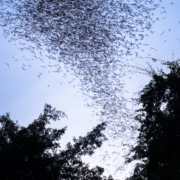How Human and Ecosystem Health Intertwine
By NCAT Sustainable Agriculture Specialist Nina Prater
Sometimes cause and effect are easy to understand. Habitat destruction, for example, obviously leads to a decline for those creatures that depend on that habitat. Less milkweed means fewer monarch butterflies. Cause, effect. But sometimes the cause and effect are not immediately apparent.
Take this example outlined in a recent study by Dr. Eyal Frank, environmental economist with the Harris School of Public Policy at the University of Chicago. Dr. Frank found that white nose syndrome, a deadly fungal disease in bats, created a domino effect that led to increased infant mortality rates in humans. Here are the dominos: bats eat insects. A disease drastically reduces bat numbers. With fewer bats, there are more insects, many of which are pests for farmers. Farmers then use more insecticides to control these pests to protect their livelihood. But an increase in the use of insecticides knocked over the most heartbreaking domino, a rise in infant mortality rates.
A study like this makes clear that we cannot separate our wellbeing from the wellbeing of the ecosystems in which we make our homes. Imbalances in the interwoven relationships that surround us can cause terrible harm in ways that can be hard to predict. This study emphasizes the need to think through how we look for solutions to challenges in our agroecosystems. We should look for solutions that will restore balance and cause the least harm.
Surprising New Research Links Infant Mortality to Crashing Bat Populations. The New York Times. September 5, 2024.

 Canva
Canva Rich Earth Institute
Rich Earth Institute
